| |
Hair Care
|
| |
| |
|
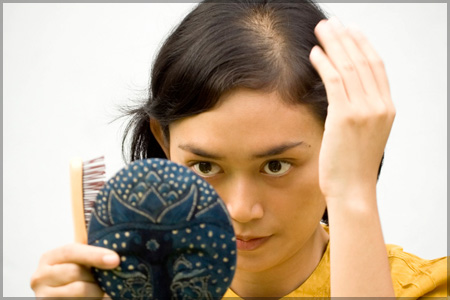 |
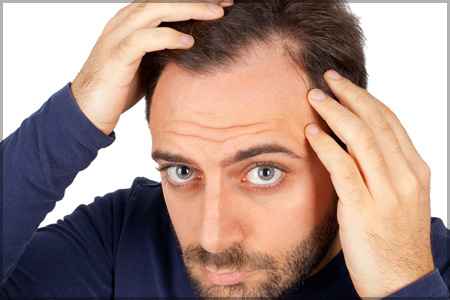 |
| |
|
• Hair fall control
• LLT (Low Level Laser Therapy)
• Dandruff control / Seborrheic Dermatitis /
• Itching of Scalp Through or unmanageable Hair Treatment |
• PATCHES ON SCALP
1) Non Surgical
2) Surgical
• Injectable / • PRP (Platelet Rich Peptides) / • Meso Therapy |
|
| |
 |
| |
|
Your hair is your crowning glory so if you fall prey to brittle and lifeless hair, it can affect your entire look and your mood as well. So make sure you do everything under the sun to inject some life into your tresses. Gentle care and a few lifestyle measures should do the trick and some damage control too.
Hair loss affects millions of people. Most of them are frustrated because they have spent a lot of money on guaranteed products and got no results.
The real and bitter fact is that, `guarantee` is a marketing word which is being used to increase sales of commercial products. So which is the best hair loss product? Unfortunately there is no correct answer to this question. No commercial products can guarantee 100% success because there are various trigger factors causing hair loss.
Why some product do gives excellent result to someone but the same product does not satisfy other? REJUVA may give you the perfect answer.
|
| |
• Hair Loss Treatment
Donít feel hopeless about your hair loss. There are many possible causes for it and each is responsible for its own genetic makeup. Our hair loss treatments are developed to treat every kind of hair disorder, assuring you a complete hair growth. Get a better insight into the causes of hair loss and its treatment methods.
• Normal Hair Loss
Are you losing 15-20 strands of hair per day? Then, donít get panic as itís absolutely normal. After every 2-6 years , the follicles shed the hair and go into a resting stage for 3 months. It is then followed by a new hair growth cycle.
• Pattern Hair Loss
When this kind of hair loss happens in males, it is known as male pattern baldness. It causes above 95% of all pattern hair loss, including both men and women. It occurs in somewhat predictable stages and is intensively progressive. Usually, pattern hair loss initiates at a premature stage of life and its evidence grows increasingly stronger with the passing of the years.
This hair loss can be triggered by various internal and external factors such as mineral deficiency, prolonged illness, hormonal imbalance, diabetes, medications, stress, smoking, pollution and others.

• Hair Loss Treatment At REJUVA
We, at REJUVA strengthen the roots of the hairs and trigger new hair growth with the use of vitamins, minerals and amino acids. A clean scalp is essential to have good hair growth. With the use of medicated moisturisers and shampoos, the scalp is cleaned. You can see the improvements only within 2 months and get the desired result only in 4 months. Your hair will stop thinning and you will get a head full of shiny black hair.
The main objective of our work is to value the customers. We care for your health and hence, to avoid any side-effect, we combine the nutrients that work better with each other. It will improve the efficiency and reduce the dosage. Moreover, we give the patients the right advise to follow post treatment.
• Hair Fall, Hair Thinning, Dandruff?s
Your Hair worries now in the hands of experts. Rejuva Holistic Solutions for all your hair needs.
Designed by our expert dermatologists, we offer a customized consultation and solution pathway to address the various hair concerns in women such as hair thinning, hair fall, dandruff or other scalp related concerns
1) Advanced combination therapy to treat different forms of hair fall in women
2) Comprises of specialized services that deliver vital nutrients and growth factors right where it matters - at the root
3) In combination with efficacious REJUVA treatments, it helps energize and rejuvenate the scalp and hair follicles, thereby controlling hair fall and stimulating stronger hair growth. |
| |
Men Hair Loss |
| |
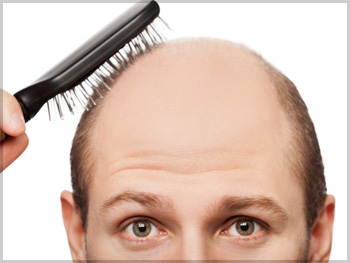 Hair loss in men is mostly genetic. We have a choice to stop hair loss and even reverse it by using modern-day regenerative treatments, to make weak hair stronger. Even if significant hair loss has happened, the lost hair can be restored using natural follicular unit restoration techniques, while at the same time minimizing future hair loss. Approximately 50% of all men will experience hair loss during their lifetime and 90% of it is genetic. Hair loss in men is mostly genetic. We have a choice to stop hair loss and even reverse it by using modern-day regenerative treatments, to make weak hair stronger. Even if significant hair loss has happened, the lost hair can be restored using natural follicular unit restoration techniques, while at the same time minimizing future hair loss. Approximately 50% of all men will experience hair loss during their lifetime and 90% of it is genetic.
Half of all men will experience noticeable hair loss during their lifetime. The cause is genetic 90 percent of the time, while the rest is considered ďmetabolicĒ hair loss.
Hair loss genes passed down from either parent might activate at any time after maturity, depending on individual genetics. When activation occurs, hair becomes sensitized to di-hydro-testosterone, or DHT, a testosterone metabolite that kicks off a chain of events that leads to a pattern of progressive miniaturization of the hair follicle. Without treatment, these hair follicles eventually will die, leading to permanent hair loss.
If the hair loss genes activate earlier in life ó for example, when a man is in his 20s ó the rate of progressive miniaturization and hair loss will be highly accelerated when compared to activation that occurs when a man is older.
|
| |
Normal Hair Growth
|
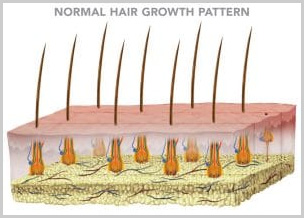 Hair is medically referred to as follicles. Each follicle grows as one, two or three hairs, or, more rarely, in groups of four or five hairs. Each follicular unit is equipped with its own glands, muscles, blood and nerve supplies. Hair is medically referred to as follicles. Each follicle grows as one, two or three hairs, or, more rarely, in groups of four or five hairs. Each follicular unit is equipped with its own glands, muscles, blood and nerve supplies.
Each follicle has an average lifespan of three to seven years and grows approximately a half inch per month. This active period of growth is referred to as the anagen phase. When the anagen phase comes to an end, the hair enters a period of regression that lasts a few weeks called the catagen phase. After the catagen phase, the hair enters a resting period of an average three months called the telogen phase. When the telogen phase is over, the hair falls out and a new anagen growth phase begins with the hair growing back.
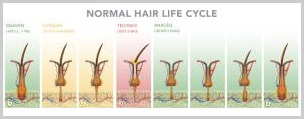
Under normal circumstances, 90 percent of our follicles are in the active anagen growth phase, while the remaining 10 percent are going through the catagen and telogen phases.
|
| |
Genetic Hair Loss and DHT
In genetic hair loss, testosterone primarily enters in the papilla, outer root sheath and sebaceous gland 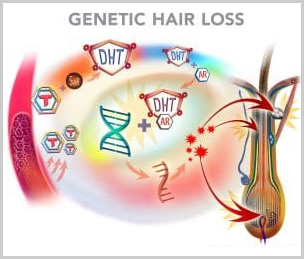 cells, where it is converted into Di-Hydro-Testosterone (DHT) by the enzyme 5-alpha reductase (5AR). The DHT binds to androgen receptors and enters the nucleus of these cells to bind with DNA, which in turn signals production of specific messenger RNA that creates follicle-damaging proteins, resulting in disruption to the normal hair-growth cycle. The anagen growth phase is cut short, and the hair regresses prematurely to the catagen phase and eventual resting telogen phase. Once the telogen phase is over, a new hair grows in but with a reduced diameter and an even shorter anagen growth phase. cells, where it is converted into Di-Hydro-Testosterone (DHT) by the enzyme 5-alpha reductase (5AR). The DHT binds to androgen receptors and enters the nucleus of these cells to bind with DNA, which in turn signals production of specific messenger RNA that creates follicle-damaging proteins, resulting in disruption to the normal hair-growth cycle. The anagen growth phase is cut short, and the hair regresses prematurely to the catagen phase and eventual resting telogen phase. Once the telogen phase is over, a new hair grows in but with a reduced diameter and an even shorter anagen growth phase.
This progressive miniaturization process repeats over and over with an ever-decreasing anagen growth phase and decreased hair diameter until eventually the hair is lost altogether. |
| |
|
Classification of Male Pattern Hair Loss
Genetic hair loss goes through typical sequences: Hair loss initially leads to gradual thinning and the frontal and temporal hairline starts receding. Finally, this develops into frontal baldness, later also involving the mid-scalp and crown area.
Male pattern hair loss is classified into seven types:
• Type I - Minimal receding of the front hairline
• Type II - Receding of both the front and side hairlines; if a vertical line is drawn in front of the ear and a second vertical line is drawn 2 cm in front of the first, the triangular recession stops in front of the second vertical line
• Type III - Receding of both the front and side hairlines, with the area of recession on both sides extending up to the vertical line in front of the ear
• Type IV - The frontal and side hairlines have receded and become extremely thin, and the recession extends beyond the vertical line in front of the ear; established loss in the crown area, although it is still clearly separated from the frontal baldness by a band of hair
• Type V - The front hairline is completely lost, but the front baldness and crown baldness are still separated from each other by a thin band of hair.
• Type VI - The bridge between front and crown baldness is lost and the entire area of baldness is greater laterally and posteriorly than the Type 5 hair loss
• Type VII - The baldness is most severe; all that remains is a band of thin hair in the occipital, parietal and temporal area |
| |
Metabolic Hair Loss |
| |
|
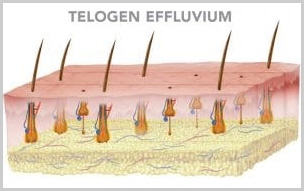 The process of metabolic hair loss is quite distinctive from genetic hair loss. There is no reduction in hair diameter or progressive miniaturization. With abrupt metabolic changes in the body, hair loss can start in few days, though it might start a few weeks or two to three months after the change. Normally 10 percent of the hairs on a scalp are in the resting telogen stage, but in metabolic hair loss, 20 to 50 percent of the follicles are in the telogen stage, leading to increased hair loss. Medically, the condition is called telogen effluvium. The process of metabolic hair loss is quite distinctive from genetic hair loss. There is no reduction in hair diameter or progressive miniaturization. With abrupt metabolic changes in the body, hair loss can start in few days, though it might start a few weeks or two to three months after the change. Normally 10 percent of the hairs on a scalp are in the resting telogen stage, but in metabolic hair loss, 20 to 50 percent of the follicles are in the telogen stage, leading to increased hair loss. Medically, the condition is called telogen effluvium.
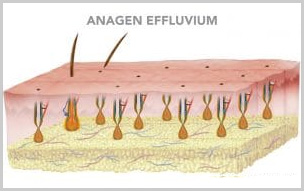
Occasionally in metabolic hair loss, more than 90 percent of the hair stops growing due to damage to the matrix cell in the area of the hair bulb. The shed hairs have a tapered down look like a pencil point; this hair loss is medically referred as anagen effluvium.
Metabolic conditions that can lead to hair loss:
• Trim regularly
The first repercussion of dry, damaged hair is split ends and the one way to solve that is regular trimming. If however you are daring enough to go chop-chop on the length then you can rid yourself of damaged hair in a sweep.
• Stay in good health
Just like your skin, your hair too is affected by what you drink, eat and how you treat your body. The math is simple; you have to ensure that your hair is getting its fair share of nutrition too. Drink plenty of water and include in your diet essential vitamins and nutrients from fresh fruits, veggies and meats like salmon and fatty acid rich foods like kale, carrots and avocados.
• A reliable hair care routine
We cannot stress enough on the dire need to use a good shampoo and conditioner that you can trust.Rather trying all, Choose a reliable brand of Shampoo and Conditioner that suits your hair best.
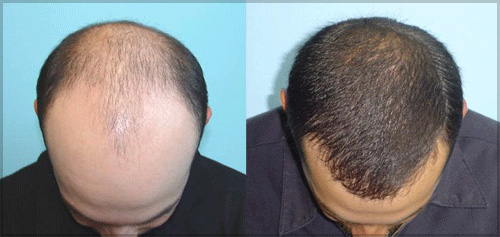 • Let your hair down • Let your hair down
Another answer to, how to treat damaged hair is letting your hair be. If you are the kind that keeps pulling your hair back into a ponytail or a bun then it is time to relieve your hair and give it a break. Donít tie your hair too tight for too long and never sleep with any hair accessory on as they can cause hair breakage and weakening.
• Pick a comb over a brush
Try and use a comb with wide teeth and avoid the brush if you have dry, damaged and brittle hair. Also make sure you donít comb your hair when still wet because thatís when it is at its weakest.
|
| |
| |
|
|